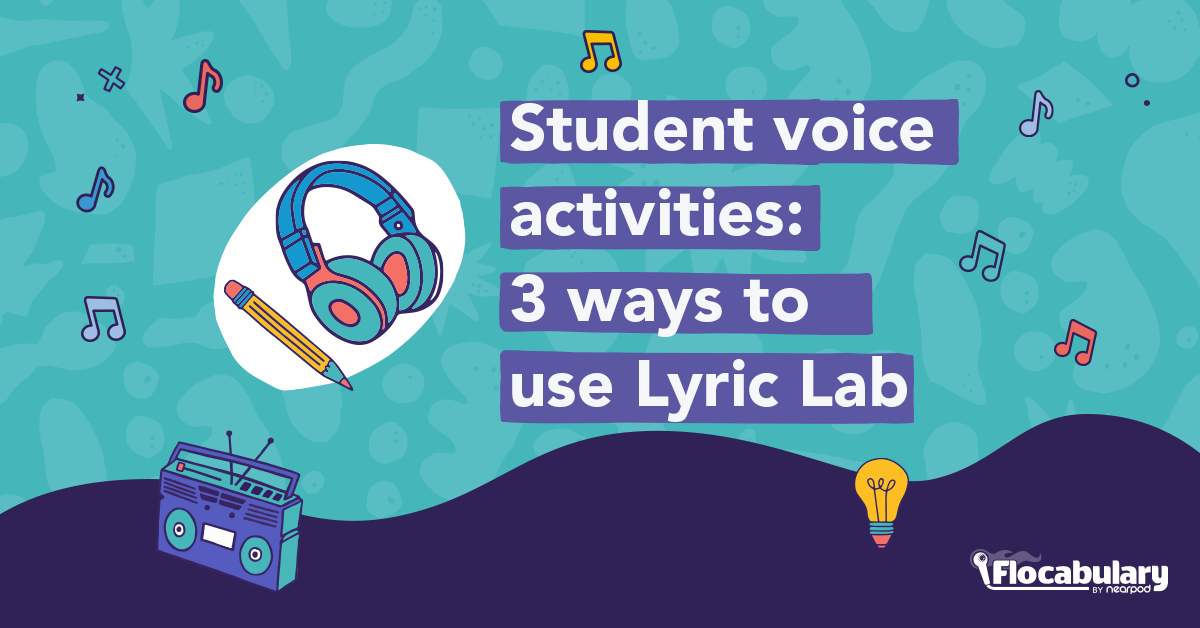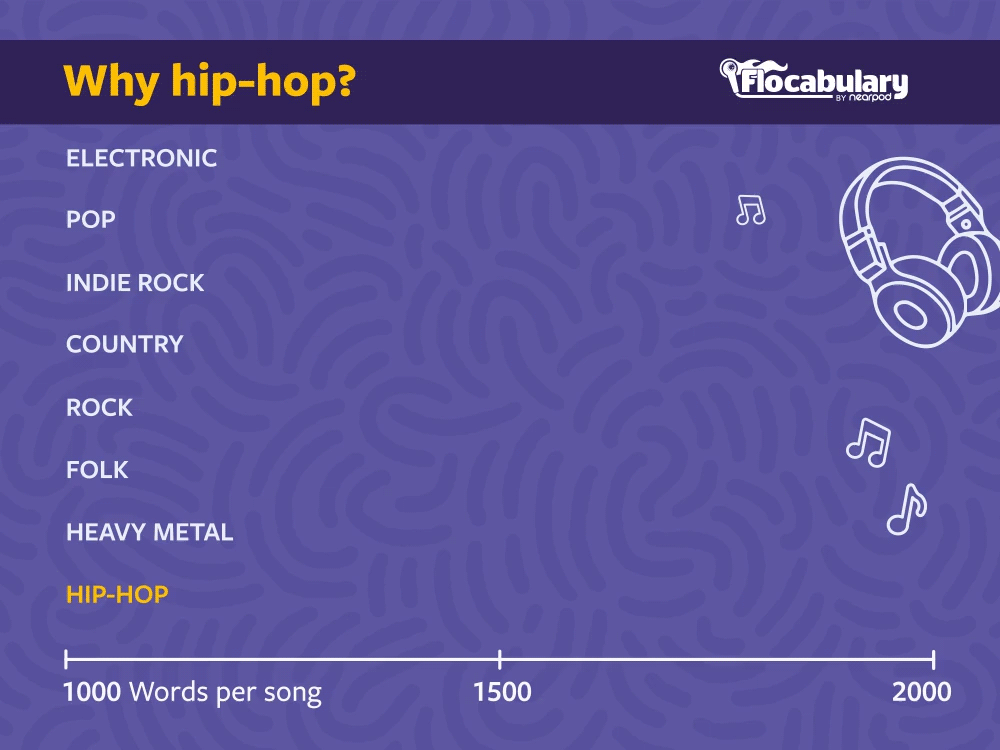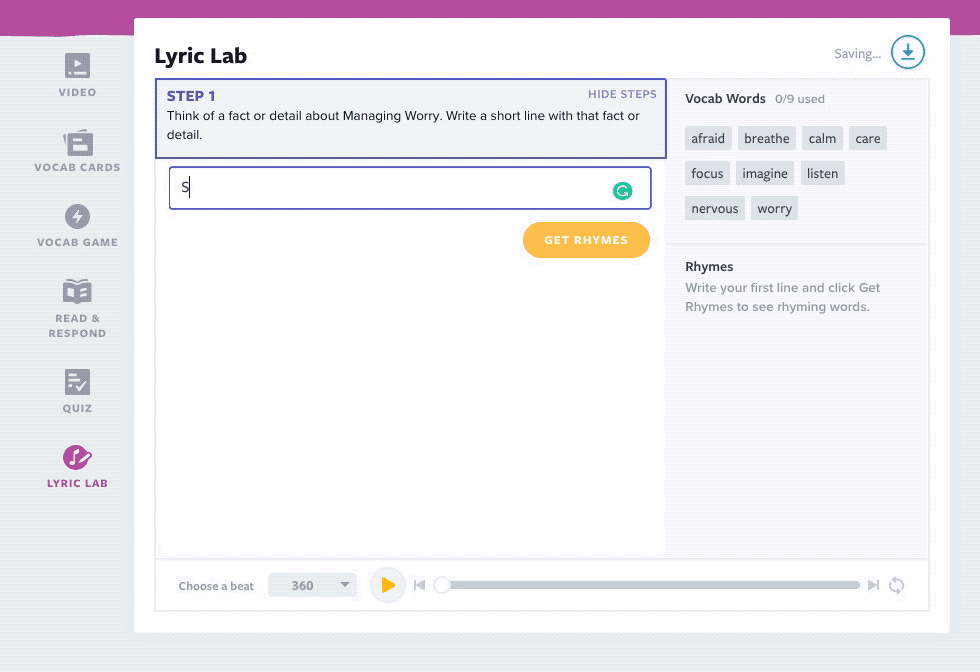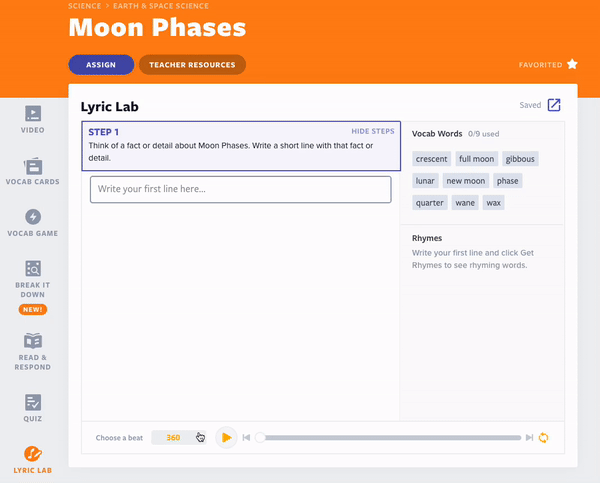
3 Ways to use Lyric Lab in the classroom for student voice
Flocabulary’s Lyric Lab is truly an educational treasure that will make student voice activities easy and fun to do in every classroom. This tool has opened doors for countless creative opportunities in the classroom by utilizing music to increase student engagement and assess student knowledge of the standard.
During the beginning stages of my first year teaching, my principal at the time, Brian Ingram, Director of Talent and Acquisition at, Memphis-Shelby County Schools, shared this with me often: “Mr. Knight, students can not learn if they are bored.” Additionally, my mother, Lei F. Washington, Director of Operations and Professional Learning at Guilford County Schools, would share that the students were bored because I, myself, the teacher, was not having fun with my instruction. As I have navigated education, I have learned that student engagement increases not only when students are having fun but also when students are provided multiple pathways to make their thinking visible.
Of the many ways to assess student learning, I believe that student voice and content expression is the most authentic form of assessment. Additionally, we know that an engaged student is a successful student. Hip-hop is the most popular genre in the world, according to Spotify, making it culturally relevant and engaging for students. On average, rap uses two to three times more words per song than other music genres, providing a rich format for teaching complex concepts and emphasizing vocabulary acquisition. For example, the alphabetical order was introduced to us through the tune of “Twinkle, Twinkle Little Star.” Even in adulthood, this is something many of us have not forgotten. This is a perfect example of how music can be used as a tool to enhance content delivery.
New to Flocabulary? Teachers can sign up for a trial to access our lesson videos and assessment activities. Administrators can get in touch with us to learn more about unlocking the full power of Flocabulary through Flocabulary Plus.
Why should teachers use music in the classroom?

Education has to feel as sweet as learning and singing our favorite song. For students a part of Generation Z, learning has to be as fun and exciting as creating a new Tik Tok video. What are the possibilities in teaching and understanding when we begin to bridge the gap between what students are already interested in and the content we want to introduce them to? This is where Lyric Lab comes in.
What is Lyric Lab?
Lyric Lab sits at the final stage of the Flocabulary lesson sequence. Students can participate in a whole group setting or use the tool separately on its own. The Flocabulary Lesson sequence uses Bloom’s taxonomy as a framework. Lyric Lab is the creation stage. Through Lyric Lab, students can demonstrate their understanding of vocabulary and enhance their writing skills by creating their own raps about the content using hip-hop instrumentals. This makes space for students to deepen their thinking and take ownership of their learning. This activity is the perfect blend between project-based learning, cultural responsiveness, and the use of music in the classroom.
How does Lyric Lab work?
So how does this work in practice? Lyric Lab works as a supportive tool for student voice activities to help write raps or poetry about the content being reviewed. When Lyric Lab is opened, students start off their own rap song by choosing an instrumental and writing a line about the content they’ve learned. A word bank is located on the right-hand side of Lyric Lab, where students are reminded to include the vocabulary words in their creations. Every time a new line begins, an additional word bank filled with words that rhyme with the last word of the previous line populates to support the student creation songwriting process. Once the rap is completed, teachers and students can export their lyrics onto print or PDF. Students can also select a beat right within Lyric Lab to perform their song.
Before students start writing their rhymes to a beat, it’s important to share the history and cultural significance of hip-hop. This is an easy way to teach vocabulary, music, and cultural history in one setting. Use this lesson to teach students about the “Fundamentals of Hip-Hop” and further contextualize the use of hip-hop for learning.
The benefits of using Lyric Lab

With Lyric Lab, teachers can promote creativity in their learning environment in ways that are culturally responsive to students. This activity also creates opportunities for students to practice vocabulary and their writing skills. This is important because research has shown a direct relationship between students’ understanding of vocabulary and the outcomes of state-mandated assessments.
Furthermore, it is important that in instructional activities, students have the space to create. Lyric Lab makes this space available. Ultimately what this fosters is an amplification of student voice and an environment that affirms student agency. This agency can be practiced by students both individually or collaboratively in groups.
Creative ways to use Lyric Lab in the classroom for student voice activities
1. “RAP up a unit”
What better way to wrap up a unit than for students to create a rap about what they’ve learned? Have students write one sentence about what they’ve learned in a unit to begin writing a rap. In a whole group setting, they can use their sentences, the instrumental beat, and the rhyming word bank to create an entire song filled with academic vocabulary and content knowledge.
2. Poetry Slam, Rap Performance, and Cypher

Poetry slams, rap performances, and cyphers are essential to the culture of hip-hop. Students can write a poem with a poetry slam while others snap their fingers to encourage their classmates. In a rap performance, students would individually create their own raps about the content. The teacher may have a minimum amount of vocabulary words that must be included in the rap. Students would perform one by one, and their peers encouraged the performance.
A rap cypher is a gathering of rappers, beatboxers, and/or break dancers in a circle, experimentally creating music together. You can gather students in a circle and make space for them to freestyle rap what they’ve learned. The teacher may input the rhymes into Lyric Lab and use the cypher to write a collective song.
3. Group Rap Project
Build your classroom community and hear from all students. This could be a group project for students to collaborate with peers and create a song using the academic content. What I have found in these types of assignments is that not only is this an opportunity for teacher assessment of student learning, but this is an opportunity for students to assess each other on their learning. Once again, music is a big part of students’ everyday life (Tik Tok, social media). With Lyric Lab, students experience what they engage in and outside of the classroom together.
Collaboration between students and teachers not only fosters mutual respect but also creates an environment where schools, students, and teachers collectively influence decision-making processes. Empowering student leadership through student-led initiatives not only prioritizes student perspectives but also instills a profound sense of ownership within the school district.
Furthermore, navigating education as a student and an educator taught me that learning was most effective when visibility into student thinking was present. For me, this is what it looks like to give fish water to swim in and birds a sky to fly in as they thrive in the pathways that work best for them.
Here’s what to remember:
- Using music in for learning experiences is an effective and culturally relevant way to engage students with curriculum and instruction.
- These recommendations rely on the teacher’s ability to trust that students have the capacity to do more heavy lifting in their own learning.
- Lyric Lab is a tool that can be used for elevating student voice in the classroom to make those multiple pathways more accessible to students.
As we continue in the work of engaging students, empowering leaders, and encouraging creativity, let us effectively use the tools we can access to provide students more access points to the skills they need to be successful. Young students, whether they’re elementary, middle school, or high school students, offer unique perspectives that enrich educational discourse. Empowering student leadership through these student-led initiatives not only prioritizes student perspectives but also instills a profound sense of ownership within the school and community.
New to Flocabulary? Teachers can sign up for a trial to access our lesson videos and assessment activities. Administrators can get in touch with us to learn more about unlocking the full power of Flocabulary through Flocabulary Plus.
